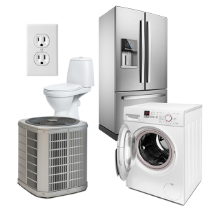Things You Can (and Can’t) Put Down Your Garbage Disposal
Do you know what’s good and what’s bad for your kitchen’s garbage disposal? There are varying opinions about what our garbage disposals can handle—here’s what you need to know to keep your disposal running smoothly.
Things you should NEVER put down your garbage disposal
First, let’s start with the things that your garbage disposal isn’t equipped to handle:
- Stringy and/or fibrous veggies. Onion skins are a particularly nefarious culprit, but corn husks, celery stalks, artichokes and other stringy vegetables shouldn’t go in a garbage disposal. Fibers from foods like these can get tangled, jamming the garbage disposal motor and blocking the drain.
- Vegetable peels. Similarly, don’t ask your disposal to grind up too many vegetable peels. You’ll eventually end up with a backlog of unappealing water in your sink and a clogged drain.
- Grease and oils. If you dump grease down your drain the only result will be a large, solidified mess.
- Egg shells. Shockingly, the membrane found on the inside of an egg shell can wrap around the blades of your garbage disposal. Small amounts are likely okay and they can help clean the blades, but don’t get carried away.
- Pits, seeds and bones. These items are too tough for your garbage disposal, so don’t even try to grind them up. Again, small amounts are generally thought to be fine, but use your best judgment.
- Coffee grounds. Some experts concede that a small amount of coffee grounds is okay, but why risk it? The small grounds will build up over time, acting just like dirt and other sediment.
- Rice and pasta. This one might come as a surprise, but the logic makes sense; ice and pasta continues to expand whenever they’re exposed to additional water.
- Non-food items. Garbage disposals are designed to shred food, not trash. Save the napkins and other non-food items for the trash can or compost bin.
It’s also worth mentioning that your garbage disposal isn’t designed for bulk food. Avoid overwhelming the motor by slowly adding small amounts of food, grinding everything up and then adding more.
What CAN go down your garbage disposal?
It’s not all doom and gloom—your garbage disposal can easily tackle a variety of food items. Here are a few things you should let your disposal handle regularly:
- Citrus rinds. Small sections of citrus fruits clean your garbage disposal and leave it smelling fresh and clean.
- Pour some dish soap into your sink, turn on the cold water and let the garbage disposal run for a minute or two. Consider doing this every time you’re done washing dishes to keep your disposal in good health.
- Fruit and veggie scraps. As long as the fruit doesn’t have a large, hard pit and the veggies aren’t overly fibrous, toss those scraps into the garbage disposal.
- Vinegar and baking soda. Another great way to clean your garbage disposal is to freeze vinegar in ice cube trays and then run them down the disposal. Your blades will stay sharp and odor-causing bacteria will be killed. If your sink is getting extra smelly, pour baking soda into the drain and let it set for several hours. Then, run the water and the garbage disposal.
2-10 HBW offers the most comprehensive Home Warranty coverage for homeowners. Let us help you protect your home.








